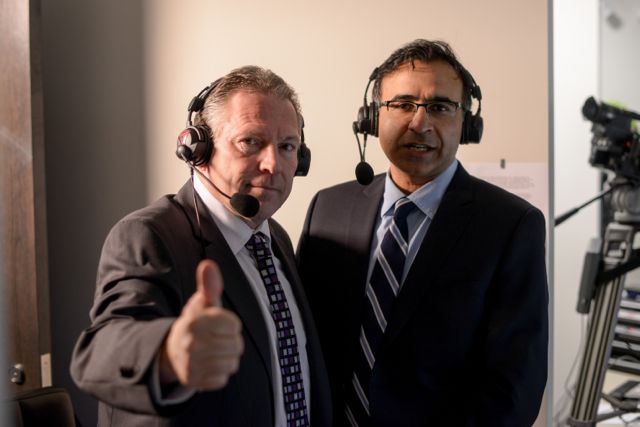"Bluelines: Summer Edition" is written by Ranjan Rupal (right), the play-by-play voice, and Greg Theberge (left), a former Memorial Cup winner and Washington Capitals defenseman and hockey analyst for The OHL Tonight on TVCogeco. Photo by Lindsay Sarazin.
For many a discontented winter, we hockey fans in North Bay wondered if the Ontario Hockey League would ever return to our city. Never seemed the most plausible answer, as the OHL had entered a period of stability in the years following the Centennials’ exit.
How ironic then, when the hockey gods chose to smile on North Bay, that the OHL is once again tossed into a whirlwind of relocations, with the Plymouth Whalers becoming the Flint Firebirds and the Belleville Bulls becoming the Hamilton Bulldogs, not to mention a peculiar bankruptcy proceeding that could very well knock Erie Otters’ owner Sherry Bassin, the game’s great pioneer, and the one who did such a fine job with Connor McDavid, out of the lineup.
Hockey is a tough game, indeed.
From these ashes, however, a new entity has emerged, though not so much like a phoenix from the flames, because that superlative is irresistibly Flinty, but more of a metamorphosis, like an AHL caterpillar awakened as an OHL butterfly and, as the people of North Bay will attest, the people of Hamilton will be the beneficiaries.
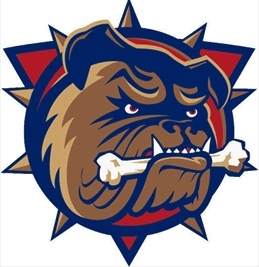
I’ve lived in both cities. Folks in Hamilton are much like those in North Bay: pragmatic and industrious, generally wary of pinstriped slicksters in big cars, puffing big cigars. We recognize value, and hard work, and try as we might, there’s always a Sudbury, or a Toronto, nearby, telling us they can, and we can’t.
And that is precisely the reason the OHL will rekindle a flame in a region that has long supported major junior hockey, dating back to the days of the Hamilton Fincups, a team coached by Bert Templeton that won the Memorial Cup in 1976, led by Dale McCourt, Ric Seiling and a rookie named Al Secord.
You might wonder how the OHL can possibly succeed in a former AHL market, one that has been bottle-fed the sweetened milk of imminent NHL superstardom, with players like Carey Price, P. K. Subban and Max Pacioretty.
An enticing answer can be found on the back of their hockey cards.
These high-profile players barely unpacked their suitcases while in Hamilton. Carey backstopped just 34 games, and more than half of these were in a single playoff run to the Calder Cup in 2007. Likewise, P. K. logged 77 games, and Patch maxed out at 82 games. Divide that by half, the number of actual home games, and the prestige of being an NHL way station dips sharply.
Compare that to Connor McDavid, who suited up for 166 games over three seasons with the Otters, and any other star player not named McDavid, who might play 250 games or more over four full seasons.
That, as my professors at the DeGroote School used to say, is your key success factor, and underlies the strength of our affection for Battalion mainstays such as Barclay Goodrow, Nick Paul, Jake Smith and, quite unbelievably, Marcus McIvor, whose 378 games set a franchise record. This familiarity creates heroes and legends, engendering the kind of fan love that builds brand loyalty.
All that’s needed in Hamilton is a smashing marketing plan, and from the moves that have been made so far, it would appear the Bulldogs are well on their way.
To learn more, I spoke with Steve Staios, the newly hired president of the Hamilton Bulldogs.
Ranjan: First of all, on behalf of the hockey community in North Bay, I want to welcome you to the OHL. 1992-93 wasn’t our best year, but as a player on the Sudbury Wolves at the time, what’s your recollection of Memorial Gardens and the city of North Bay?
Steve Staios: The first thing I remember was they were a tough team. Any time I went in there it was always a physical game. It was a strong team and a knowledgeable fan base. So it’s good to see that hockey is back in North Bay.
Ranjan: In the interest of talking solely about the Hamilton Bulldogs, I’m going to resist delving any further into your illustrious hockey career, and its fascinating twists and turns, except for this…a question texted to me from my broadcast partner, Greg Theberge…how has over 1,000 NHL games prepared you for this opportunity?
Steve Staios: That’s a good question. When you're fortunate to play the game as long as I did, at the NHL level, you see a lot of different dynamics, as far as how teams are constructed and built and from the management perspective, how different coaches approach the game.
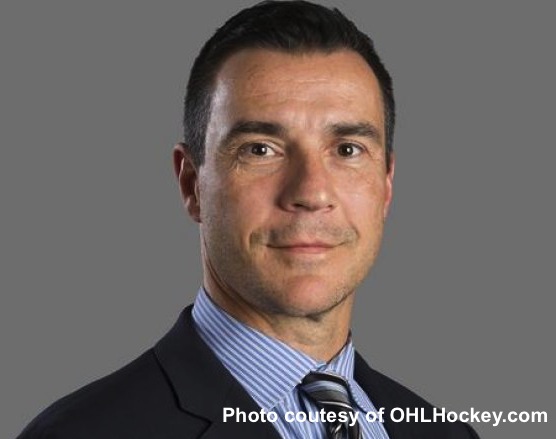
I've been on successful teams, and struggling teams. I've been on expansion teams, and Stanley Cup finalists. All these different dynamics, from the people you meet, from whatever role that they’re in, I think that you can learn a lot.
As far as different ownership situations that I've been a part of...I was part of the Edmonton Oilers when there were a group of owners that sold to Darryl Katz, a single owner, and you see how the dynamics change in that regard. An ownership change when I was in Vancouver with the Canucks, when the Griffiths family owned the team, and John McCaw bought the team.
I think, as a player, you really try and focus on getting yourself prepared to play games, but when you look back and reflect on it, you can take all these different experiences and pick out the good and the bad in these situations, and how the dynamics may have worked, or not worked, and what the reasons were that they didn’t. Those are the types of experiences that I'll look at to help me out in my role now.
Ranjan: Was there one particular experience that could serve as a model?
Steve Staios: I wouldn’t point to just one model. I think there’s parts from all of them that work...and don’t work.
Ranjan: The hockey world is small. Describe the connection that brought you to Hamilton?
Steve Staios: The connection was Michael Andlauer. In 2004-05, NHL players were locked out for the entire season. Hamilton is my hometown, and my wife Susannah and I wanted to do something to give back to the community here. So I purchased a suite that would allow the kids from Camp Trillium to come in and use it. These kids are going through some difficult times and treatments, and trying to get healthy. I figured that having some entertainment would be good for them, to see hockey games and shows and things like that. At that point I met Michael Andlauer, and the two things that stuck out to me: first, he’s very passionate about hockey, and very passionate about hockey in Hamilton. Growing up here, it’s a city that I identified with. I think it has a lot to do with the type of person that I am. We stayed in contact, and became friends throughout my playing career. We kept in touch and when this opportunity came about, he asked me if I’d be interested. The talks got a little more serious after the season with the Toronto Maple Leafs. That connection grew, and we spoke to the Leafs about it. I’ve got a great relationship with Brendan Shanahan, who guided me through this.
Ranjan: There are zero degrees of separation between yourself and George Burnett, your coach with the Niagara Falls Thunder. How important was it for the Bulldogs to lock up George as the head coach?
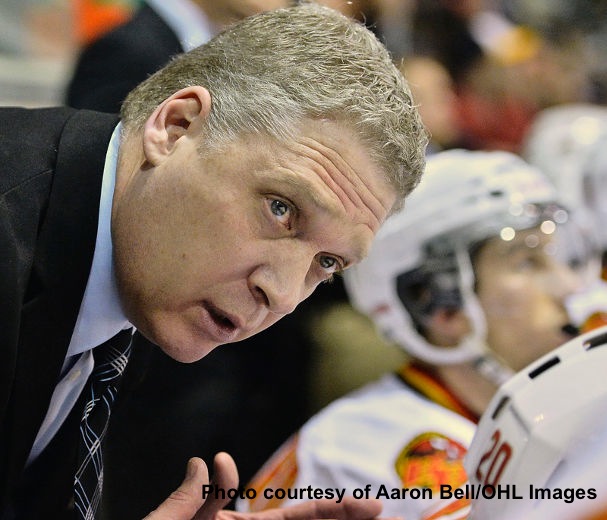
Veteran head coach and general manager George Burnett
Steve Staios: For me to step in this role, having to learn the Ontario Hockey League, and to have a person of George Burnett’s stature here is great, both for me and for our organization. He’s an incredibly detailed, diligent, hard-working coach and general manager, and a great resource, and he’s had success in the League. We’ll develop our relationship the same way as when he was my coach, and I was the player, and develop it the same way with me as the president, and he as the general manager. It’s a real positive for me.
Ranjan: I have to ask…because for many, working in the Toronto Maple Leafs organization is a dream job. But even Brendan Shanahan told you that only an idiot would pass up the opportunity Michael presented here. In a world where everyone strives to go from the OHL to the NHL, describe how going the other way made sense for you…
Steve Staios: I think, initially, when people look at it from the outside, they would say, “you're in the National Hockey League with the Toronto Maple leafs, in a position to grow with this team that’s rebuilding.” But this opportunity, because it was in my hometown, it’s hockey, and it’s with a terrific owner with a lot of passion, it was just too good an opportunity to pass up.
Ranjan: Some very good hockey people did not survive an arduous season with the Toronto Maple Leafs. You were front, and centre, behind the bench on Saturday night on Hockey Night in Canada, during the worst of it. What did you learn?
Steve Staios: I learned a lot. I think you can learn more in the tough times. You learn a lot about yourself, and about the people around you. Unfortunately in our business, a lot of good people get moved out. But in the case of the Toronto Maple Leafs, it seemed like a necessary change, and some people just got caught in the crosshairs of it. But having said that, I learned a lot from the leadership of Brendan Shanahan. It’s not an easy position to be in, there are tough decisions that you have to make on a daily basis.
You have to trust the people around you. You have to trust your instincts. I learned from all levels. I learned from the president of our team, I learned from Brian Burke before that, I learned from Dave Nonis, both great men, you know, a Stanley Cup for Brian in Anaheim. I learned from being on the bench with Steve Spott and Peter Horachek. I learned from multi-levels, from presidency, to management, to coaching, but, as difficult as it was, it was probably the most…I’m not sure the word for it…intriguing…learning time for me post-playing career.
Ranjan: Following the announcement that the Bulls were moving to Hamilton, the first question in my mind: Can OHL hockey thrive in Hamilton?
Steve Staios: Yes it can. I feel like we have an incredibly strong and passionate fan base. The American Hockey League has challenges in reaching the community. Working closely with the Toronto Marlies as the Director of Development, you see the challenges. The coaching staff goes in and puts a lineup on the board after practice, the day before a game, and that lineup changes by two or three players for the upcoming game. There’s a lot of transition...the best players aren’t there for very long, there’s a lot of movement in that regard.
The schedule is demanding. It’s much more difficult to reach the community, which is our number one task here in Hamilton. We want the people of Hamilton to identify with our team. We want them to be proud of the effort, of the product, and I would assume it’s the same in North Bay. I think that North Bay is really engaged with their team and happy to have them back. That’s the idea here. We want to have an Ontario Hockey League team that our fans, our community, and the citizens of Hamilton can identify with. We want the OHL to have a team here in Hamilton forever. We want this to be something that we can build, that the city will be proud of.
Belleville Bulls Historical Record: 2012 - 2015
| Year | Conf | Team | GP | W | L | OTL | SOL | GF | GA | PTS | Finish |
|---|---|---|---|---|---|---|---|---|---|---|---|
| 2014-15 | 7th | Belleville | 68 | 27 | 33 | 3 | 5 | 3.1 | 3.78 | 62 | 1st Rd |
| 2013-14 | 9th | Belleville | 68 | 23 | 38 | 4 | 3 | 3.2 | 4.38 | 53 | DNQ |
| 2012-13 | 1st | Belleville | 68 | 44 | 16 | 5 | 3 | 3.5 | 2.57 | 96 | 3rd Rd |
Ranjan: At various times, Hamilton has been courted as a possible NHL site while, in reality, they’re getting an OHL team. Is there a sense of insult within the community?
Steve Staios: If there is, I haven’t sensed it. I think there’s great energy, and a buzz in the community about the Ontario Hockey League coming back to Hamilton. With the OHL brand, Commissioner David Branch has a great job of building our League. What’s great is we’re developing hockey players and we’re developing great young men. They’re contributing citizens in our communities, post-playing, even if they don’t move on in hockey. We emphasize education, and being good people is at the forefront. Recently, I presented at the OHL awards, and I was sitting with Commissioner Branch, and we were struck by how incredibly poised and well spoken the young men in the Ontario Hockey League were.
Ranjan: Is there wisdom in simply borrowing the American Hockey League marketing playbook?
Steve Staios: It’ll be different. There are some differences. You’re running a hockey team in the same market, but the brand and the product will be different.
Ranjan: Pricing starts at $12 a ticket, a very attractive price point...
Steve Staios: We want people to come in and get to see how the players play. We want them to be in the building and enjoy it. We want the experience for fans to be one that they want to be in the building and they take pride in cheering our team on.
Ranjan: The alumni question intrigues me because hockey fans treasure the ongoing relationship with alumni. In North Bay, there’s some distance between the fans and the stars from the Brampton Battalion era, namely Cody Hodgson and Matt Duchene. At the top of your franchise’s list: P.K. Subban. His junior career was with the Belleville Bulls, but he also played with Hamilton’s AHL Bulldogs. Describe how your alumni could help the franchise…
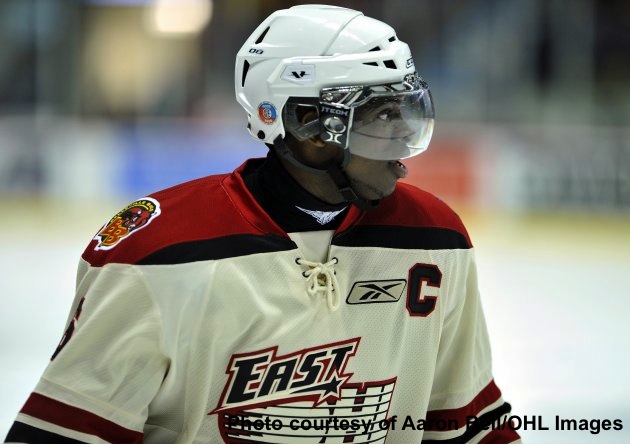
A youthful P. K. Subban shown here, played for both Belleville (OHL) and Hamilton (AHL).
Steve Staios: I think we will identify with our alumni, and there is a rich history here in Hamilton that I don’t think has been exposed. We’ve had great players come out of this area, from all eras. I was honoured and fortunate enough to play for Pat Quinn when he was a general manager and a coach. He always identified himself with Hamilton. We have great people that have come through Hamilton that have been solid hockey people, and we want people to know that there is a rich history.
Ranjan: Even during your playing days, you took an interest in what was going on around the game. In your time as captain of the Atlanta Thrashers, was there anything you learned about selling pro hockey in the Peach State that might be applicable to selling OHL hockey in Steeltown?
Steve Staios: Possibly. Atlanta was a feeling out process in the first year, for sure. It got more comfortable in the second year. But the team didn’t have the success on the ice that’s required to engage a fan base as well. I believe there was one playoff series in ten years there.
Ranjan: The arena is now called FirstOntario Centre, and seats 17,383 for hockey. This year, attendance for the AHL Bulldogs ranged from 2,500 to 10,000. Describe how this arena can work for the OHL Bulldogs…
Steve Staios: It’ll work by us creating a good in-game experience, and by us having a good product on the ice. I understand the challenges of being in a bigger arena, but if the product on the ice is something that people are proud to come and see, I don’t think it matters what size the arena is.
Ranjan: As a point of comparison, or bragging really, North Bay was able to secure 2,600 seasons tickets subscriptions seemingly within days. Describe your targets and how the push for subscriptions is going so far…
Steve Staios: We’re above where the American Hockey League team was at this point last year.
Ranjan: The FirstOntario Centre is the type of venue that could host the Subway SuperSeries against the Russian all-stars, or the World Junior Championships, or the Memorial Cup. Have these conversations happened, and describe the importance of these showcases in developing your market?
Steve Staios: I think building our brand comes first. This is pretty much Day 5, I think, [laughs] so these are all things that we’ll discuss internally as we move forward. There’s a lot of work that we need to do before we get to those conversations. What we want to do is be a market and a team that is a gold standard. We want to make sure that we’re a team that players want to come play for, and build our brand that way. My job is to eliminate excuses from all angles, and there’s a number of things we need to get to before those tournaments.
Ranjan: Okay, a text from Greg Theberge, and I think it touches on the notion of developing support from the grassroots: Steve, you came up through the Hamilton Huskies program. For the Bulldogs, describe the importance of building relationships with Hamilton minor hockey…
Steve Staios: I think it’s critical. When I was with the Hamilton Huskies, we had the Hamilton Steelhawks here. As a young player, you’re in awe of the players on the ice. You want young players in our community to say, I want to play for the Hamilton Bulldogs, I want to step on that ice at FirstOntario Centre, and get them inspired, get them to identify with a player or two. We definitely will reach out to the community, and I know there’s a lot of good hockey players that we’ve produced here in Hamilton.
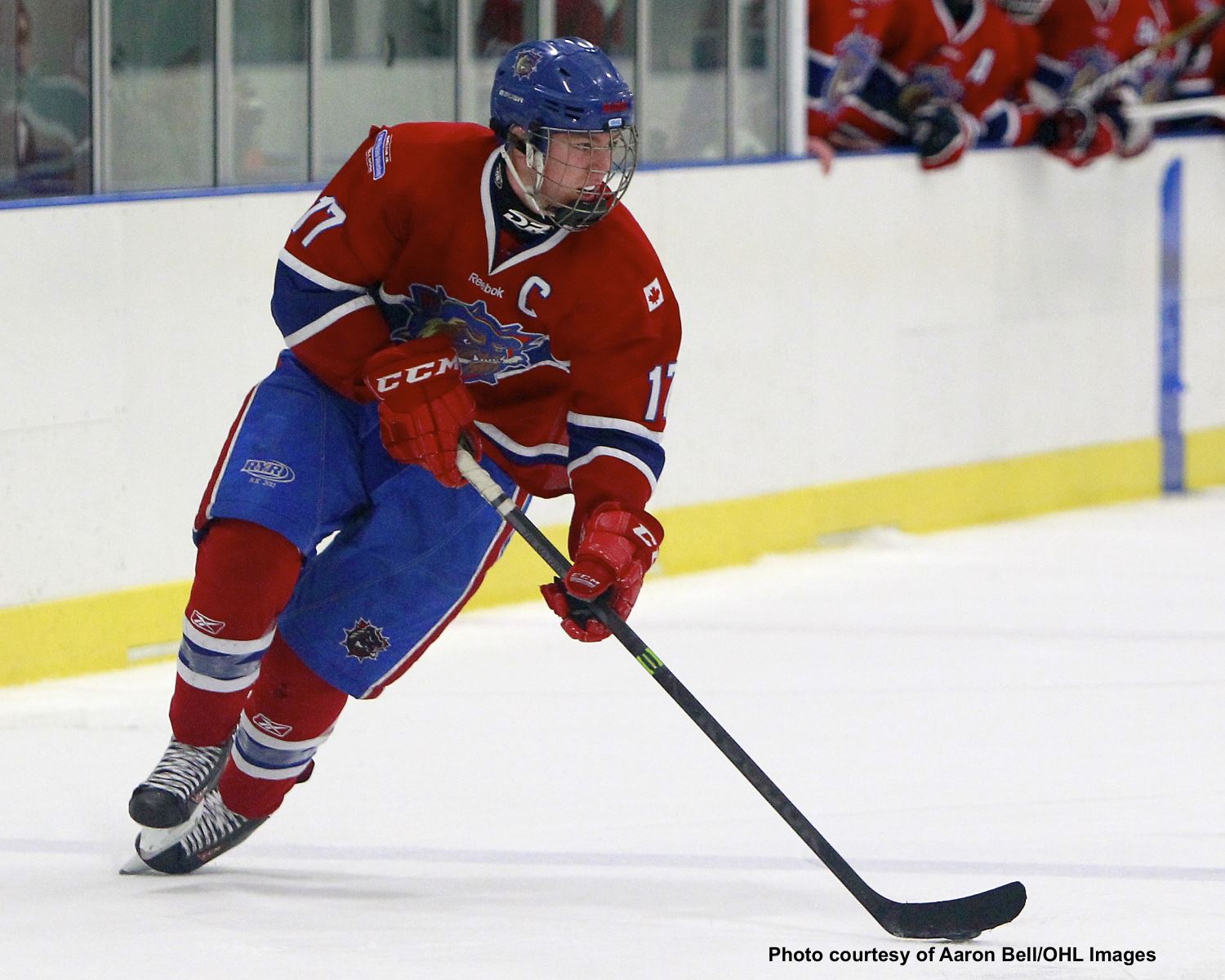
Selected 4th overall in 2014 by the Bulls, Brandon Saigeon was a Hamilton Jr. Bulldogs Minor Midget
Ranjan: For a minor hockey player, certainly the line of sight between minor hockey and the OHL is more direct than that between minor hockey and the AHL…
Steve Staios: I'd agree with that. The OHL is a brand that young players can identify with a little easier.
Ranjan: Steve, what if we could script a home opener against the Niagara Icedogs… Describe the possibilities of that rivalry…
Steve Staios: I think we’re in a good location to develop rivalries with a number of teams, and have fans from other centres come in and cheer their teams on in our building. From my experience, rivalries are built though playoff battles. It remains to be seen who our rivals will be.
Ranjan: One of the greatest moments in Canadian hockey history occurred at Hamilton’s Copps Coliseum, in the 1987 Canada Cup, and Mario Lemieux scores the game-winning goal against the Soviets. Do you remember where a 14-year old Steve Staios was at that moment?
Steve Staios: 1987. Yes. I was jumping up and down on my coffee table in the family room. I remember it well!
